We have developed various types of geotechnical tests: (1) scaled model testing, in which we aim to address the reclamation related geotechnical problems, such as sedimentation and consolidation of marine deposits, marine reclamation by super-fast consolidation methods, FRP pile behaviour filled with sand or cemented sand, and clay-FRP pile interaction under static and cyclic loadings; (2) advanced soil element testing, in which the soil element performance can be clarified by several advanced testing apparatuses, including multi-functional soil-structure interface testing apparatus, PolyU-patented true triaxial apparatus, dynamic hollow cylinder apparatus, and biaxial testing apparatus; and (3) soil microstructural testing, in which the soil microstructure can be well identified by X-ray computed micro-tomography, scanning electron microscope (SEM) and mercury intrusion porosimetry (MIP) test, with the relevant apparatus in PolyU and CEE.
1.1 Sedimentation and consolidation of marine deposits for reclamation
Hong Kong faces severe scarcity of construction land and reclamation is an effective solution. To reduce the expense of filling material and the environmental impact, sometimes the marine clays on the neighboring seabed would be used as filling material. However, the poor engineering properties of marine clay would induce difficulties for construction. Another problem is that there are two stages during the whole reclamation process: sedimentation and consolidation. Traditional research focuses on primary consolidation only. In addition, conventional tests use different devices to study sedimentation and consolidation separately. However, the soil deformation is a continuous process. This study is to development a novel apparatus for simulating the complete reclamation process in a continuous way; to propose a unifying model for linking sedimentation and consolidation; and to find a fast and effective way for soil improvement in reclamation.


1.2 Marine reclamation by super-fast consolidation methods
Ground improvement methods are usually introduced to accelerate the consolidation process of the dredged soil. Prefabricated vertical drains (PVDs) with vacuum preloading and surcharge preloading are commonly used in reclamation projects. Considering the problems existed in PVDs method, like time-consuming, limited vacuum pressure, prefabricated horizontal drains (PHDs) with vacuum preloading is jointly studied to increase the efficiency. This study is to investigate the combined efficiency of PVDs and PHDs, providing a critical support to the application of this proposed new super-fast consolidation method in practical reclamation projects. The application of multiple layers of PHDs, and its effective treating height will be studied. A new theory for the PHDs and PVDs with vacuum preloading in Hong Kong marine deposit will be proposed based on the large-scale physical model test.


1.3 FRP pile filled with sand or cemented sand
Steel is commonly adopted for the pile-wall in reclamation engineering, but its corrosion poses a great challenge to the service life. By contrast, a new type of corrosion-resistant material, fiber-reinforced polymer (FRP), is getting increasing attention as an alternative of steel in marine environment. The FRP material directly eliminates the corrosion issue, thereby bringing sustainability benefits to marine infrastructures. In addition, in reclamation engineering, sand or cemented sand will be filled into the FRP pile to increase its stability. Therefore, the flexural behavior and compressive behavior of the FRP pile should be clearly understood. Some findings can be summarized that: (1) sand filling in the FRP piles can increase its ductility in terms of flexural behavior but cannot increase its stiffness, and cemented sand filling in the FRP pile can increase the stiffness of the FRP pile; (2) filling sand in FRP piles can improve the ductility of piles and avoid buckling problem in the compression test, and the ultimate compressive stress of cemented sand-filled FRP pile is lower than sand-filled FRP pile.


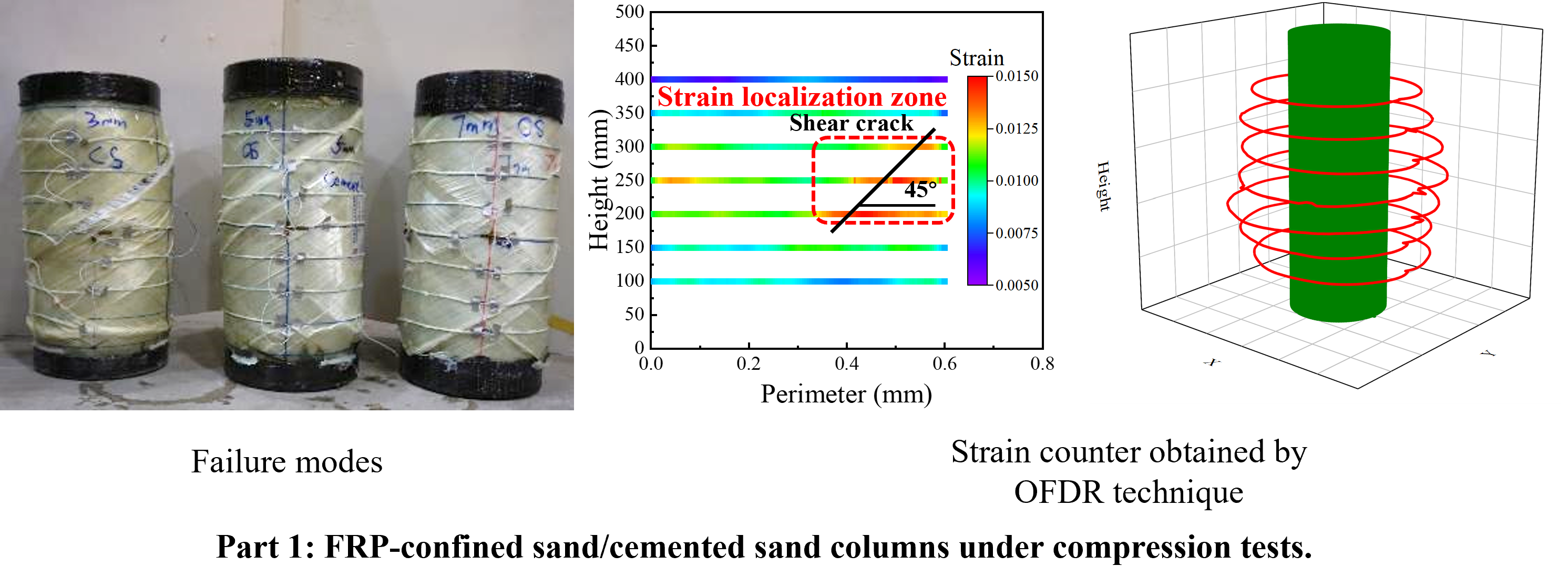

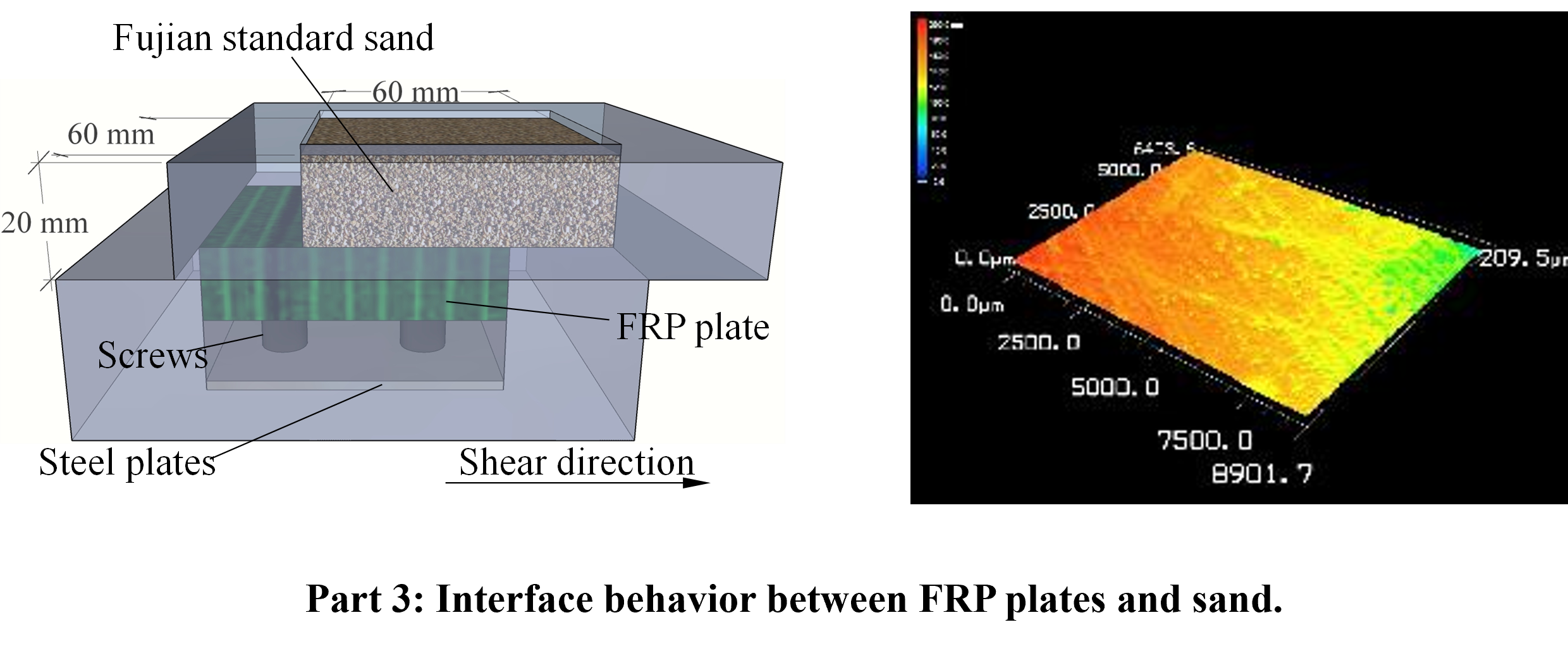

1.4 Clay-FRP pile interaction under static and cyclic loadings
The interface shear behaviour between pile materials (steel, concrete, and wood) and marine clay is not sufficient known. To design reliable and cost-effective pile foundation in the coastal areas, it is essential to understand the mechanical behaviour at the interface of the pile and marine clay. Since the studies show that the application of FRP or composites with other construction materials, such as steel, concrete, etc., can sufficiently improve the engineering properties of pile foundation, it is crucial to study the marine clay-FRP interface behaviour in details for better engineering designs and applications. This study is to design and develop a new physical model for the study of the marine clay-FRP interface behaviour under complex static and cyclic loadings; and to study the variations of interface pore pressure and soil stresses.
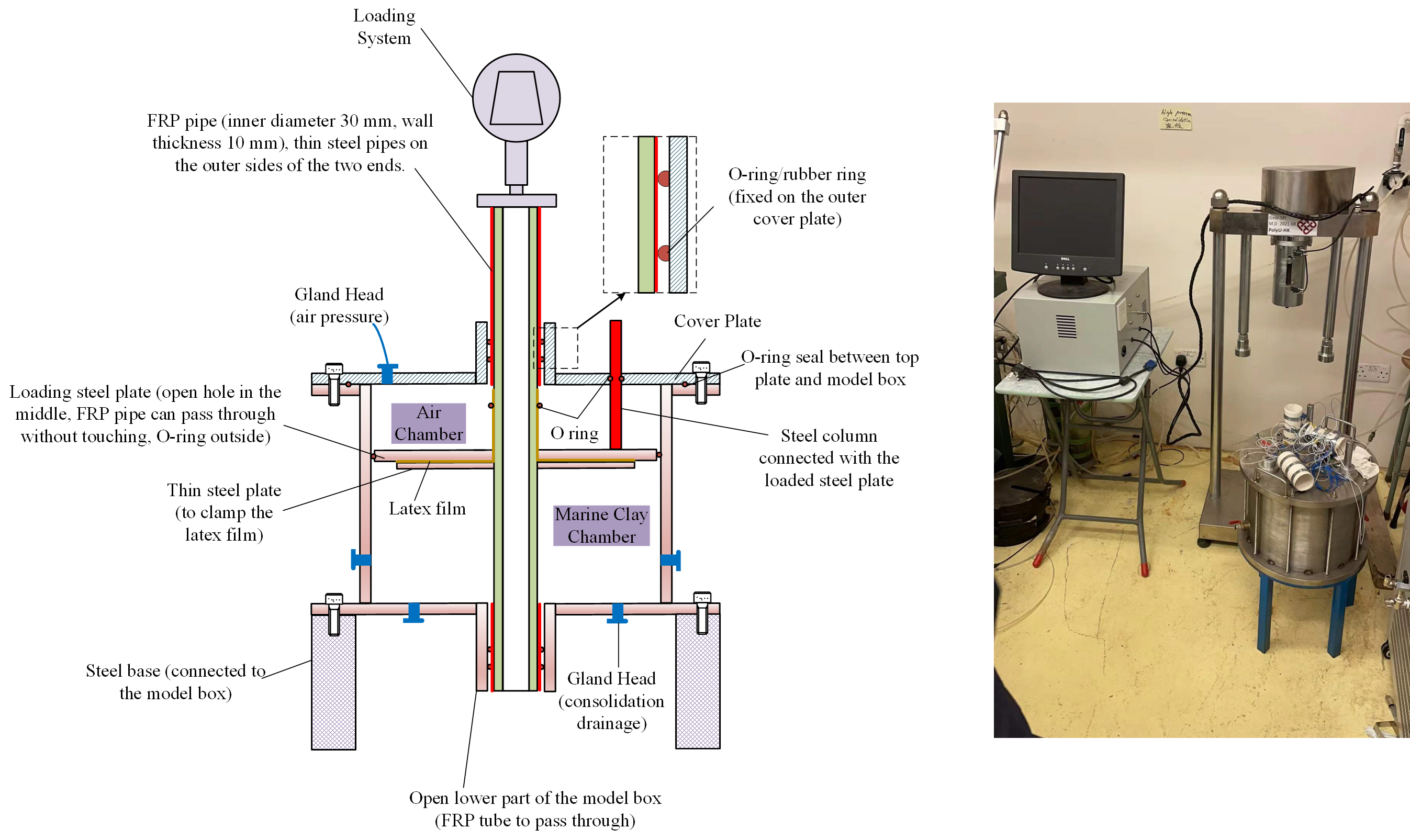
1.5 Trapdoor suffusion testing apparatus
The apparatus has the following features: (1) vertical maximum load of 100 kPa with constant normal stress application; (2) soil box internal dimensions of 1000×300×600 mm with a base of 20 alloy blocks for customizable selection; (3) adjustable trapdoor width and number for simulating unloading; (4) water supply system controlling pressure or seepage velocity for horizontal and vertical flow; and (5) high-precision servo controller with 100 mm maximum displacement, speed range of 0.1–2.0 mm/min, and positioning accuracy of 0.05 mm.
Capable of simulating soil arching by lowering a trapdoor and inducing suffusion under horizontal seepage flow in gap-graded soils; equipped with vertical loading system for constant normal stress, water supply for controlled hydraulic gradients, screens and perforated plates for seepage boundaries, and sensors for earth pressures, pore water pressures, surface displacements, and eroded mass collection.
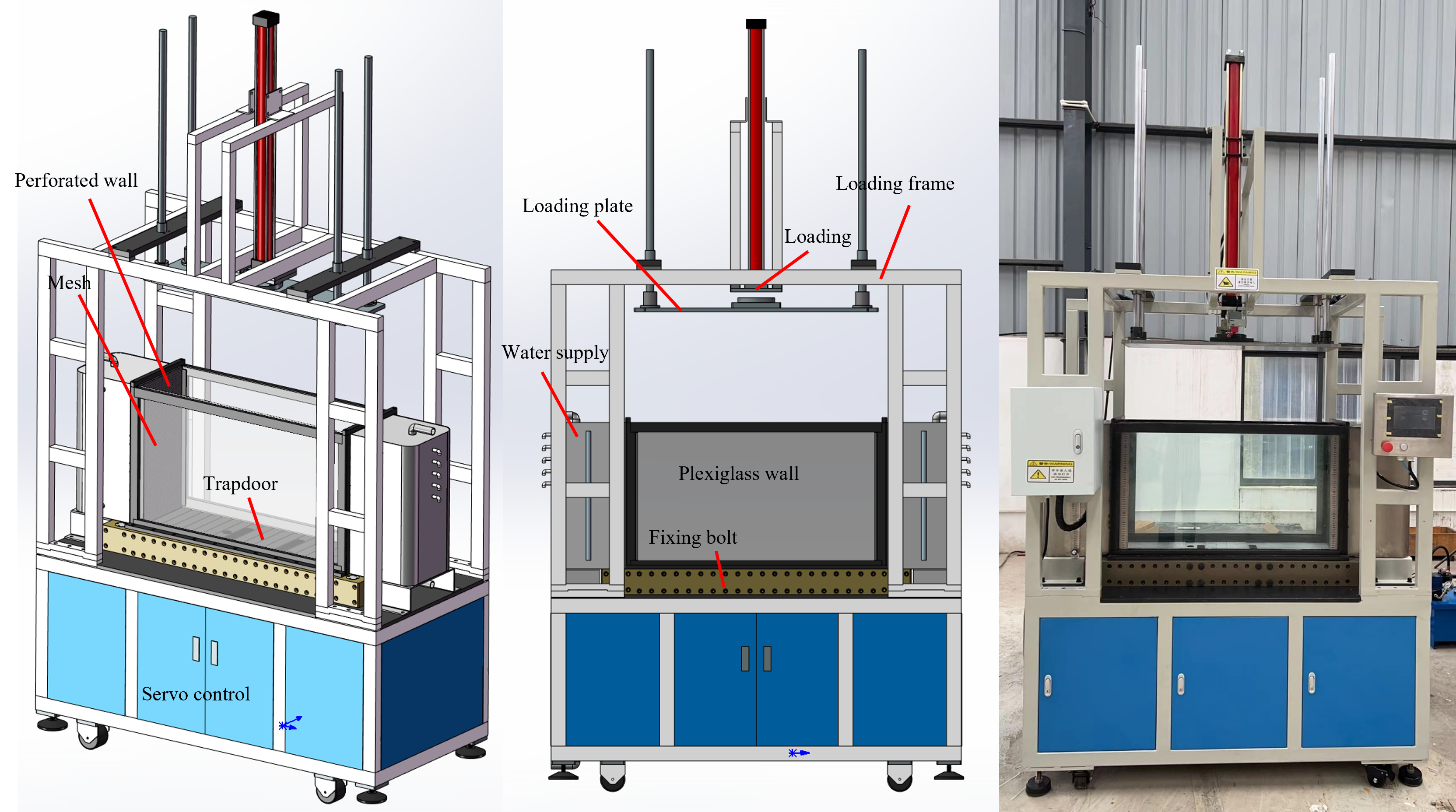
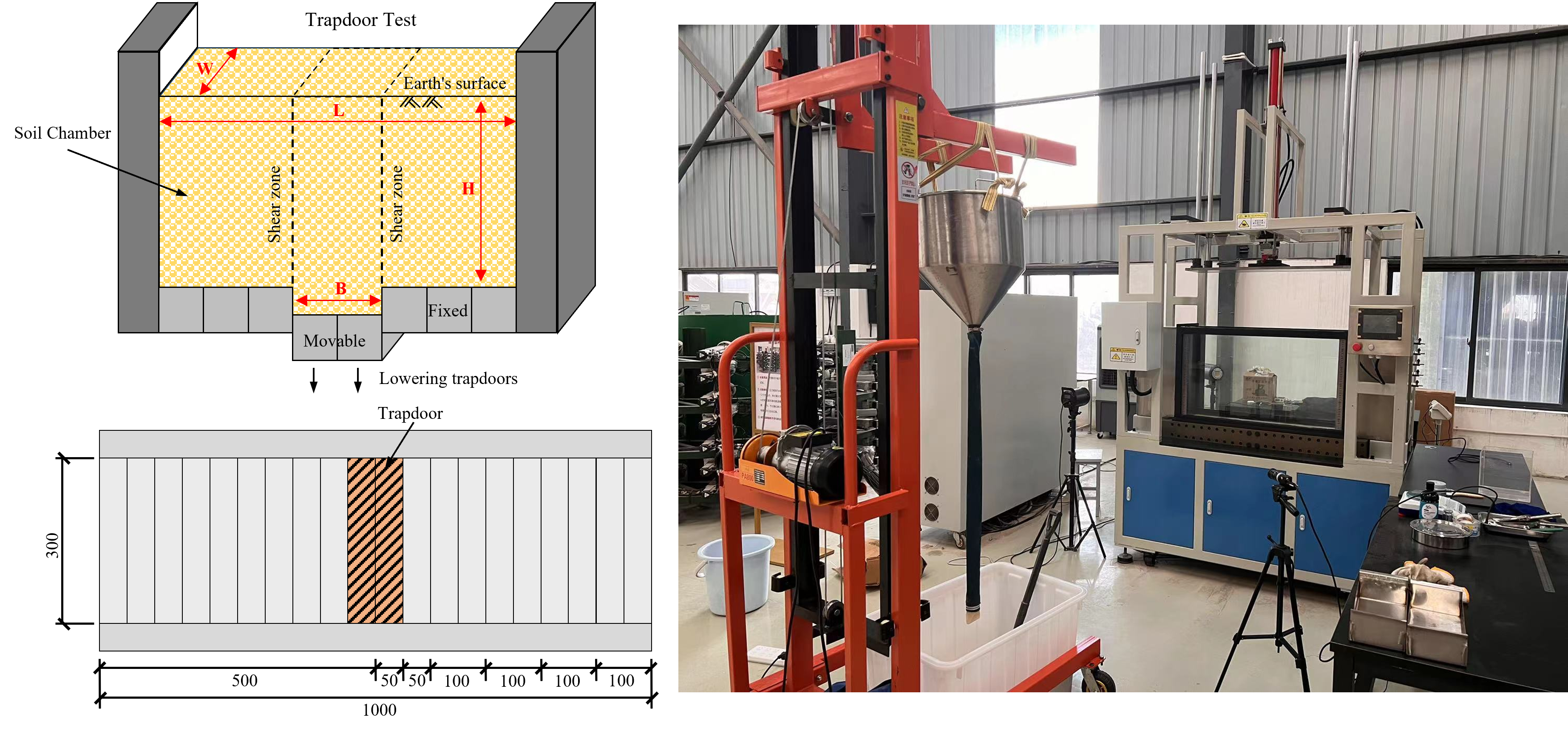
2.1 Multi-functional soil-structure interface testing apparatus
The apparatus has the following features: (1) constant normal stress and constant normal stiffness can be applied; (2) in the shear direction, both monotonic and cyclic loadings can be applied; and (3) temperature control can be fulfilled for the testing sample.
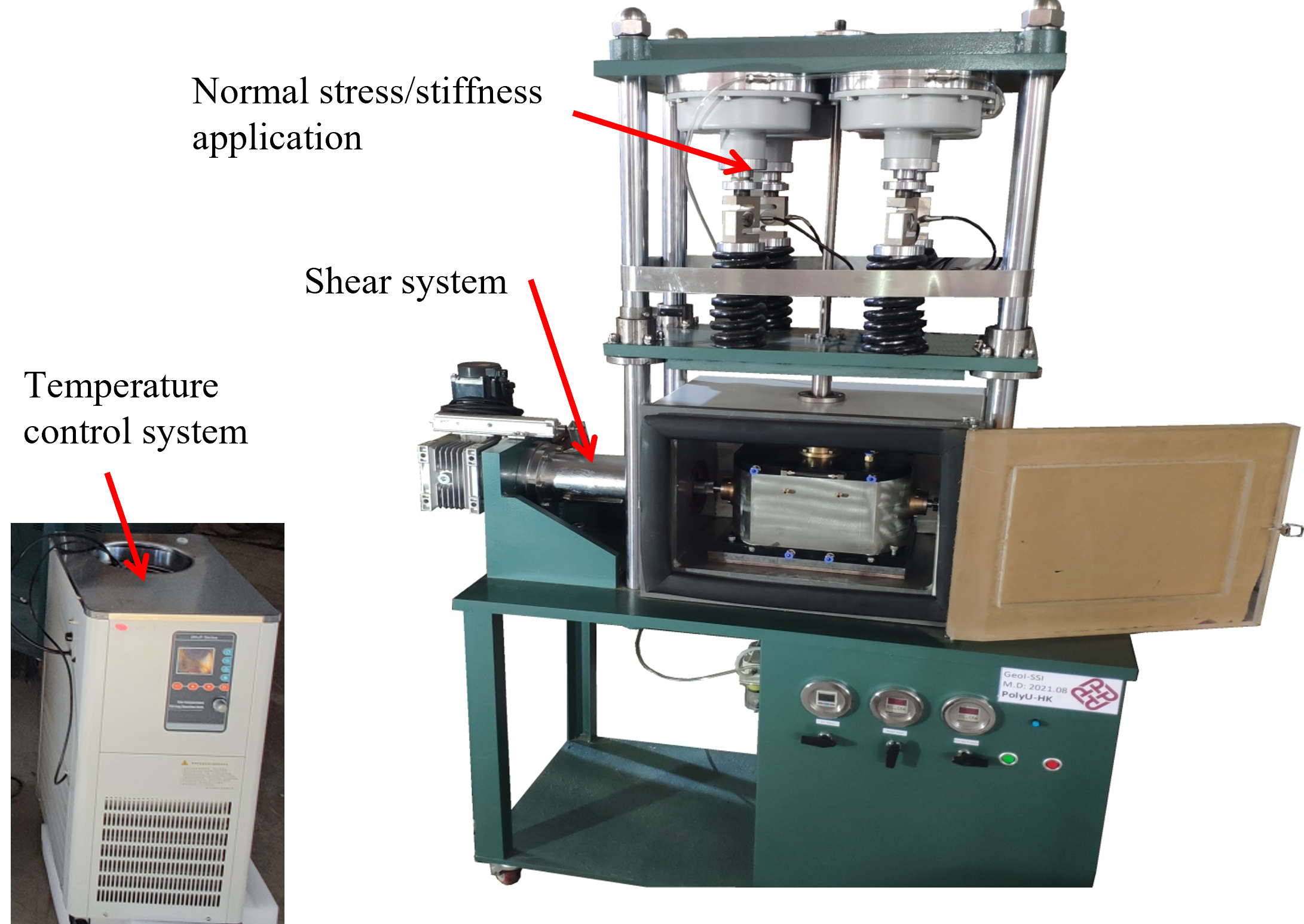

2.2 PolyU-patented true triaxial apparatus
The true triaxial apparatus was developed by Prof. Jian-Hua Yin, and is a laboratory testing equipment to study the soil behaviour under three-dimensional stress state, which is the real state of in-situ soils. The sliding loading plates are patented by PolyU.
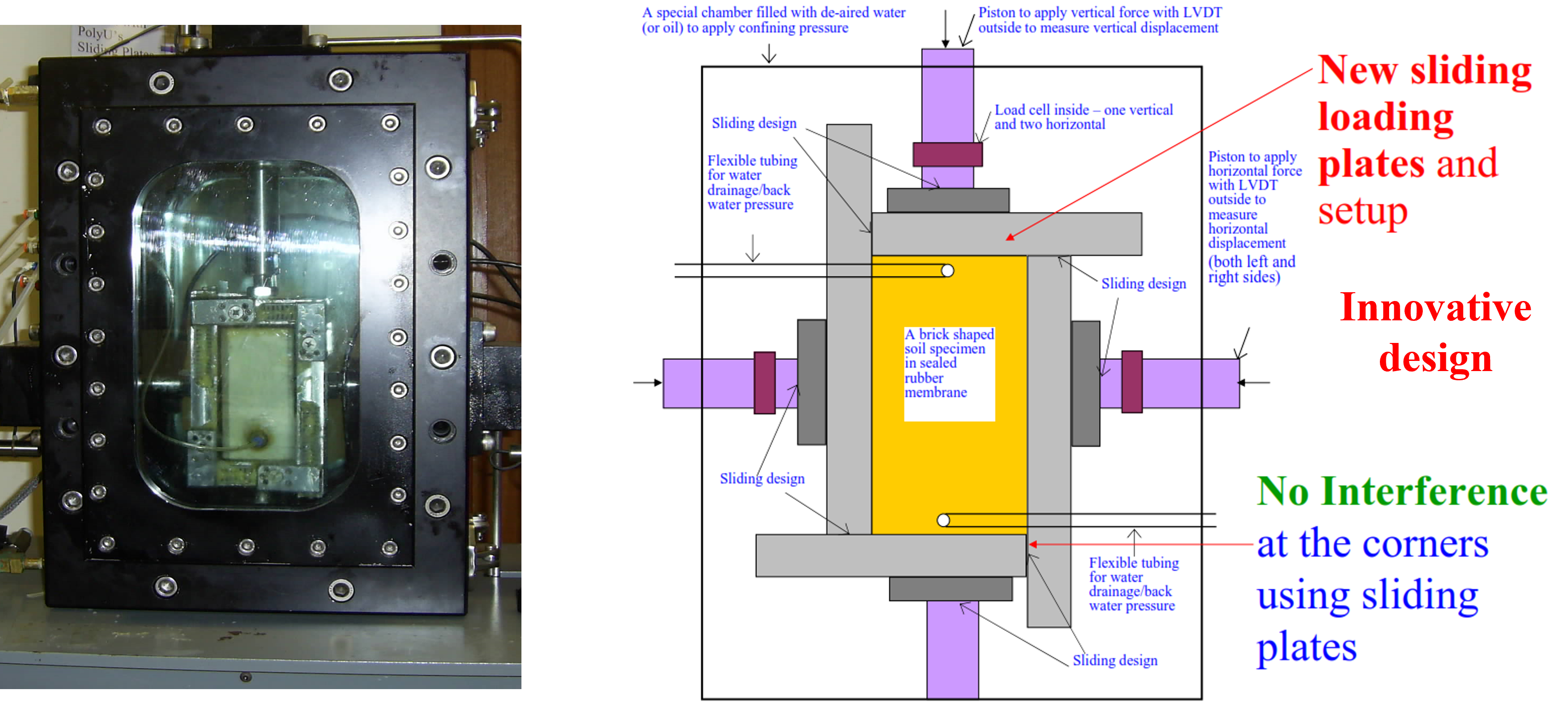
2.3 Dynamic hollow cylinder apparatus
Capable of controlling 4 independent loadings for studying behaviour of a hollow soil specimen under (a) pure shearing; (b) plane strain; (c) rotation of the principal stress; (d) influence of the middle principal stress.

2.4 Biaxial testing apparatus
Capable of simulating plain strain testing condition of soils (1 direction confining pressure, 1 direction fix end, 1 direction deviator stress).
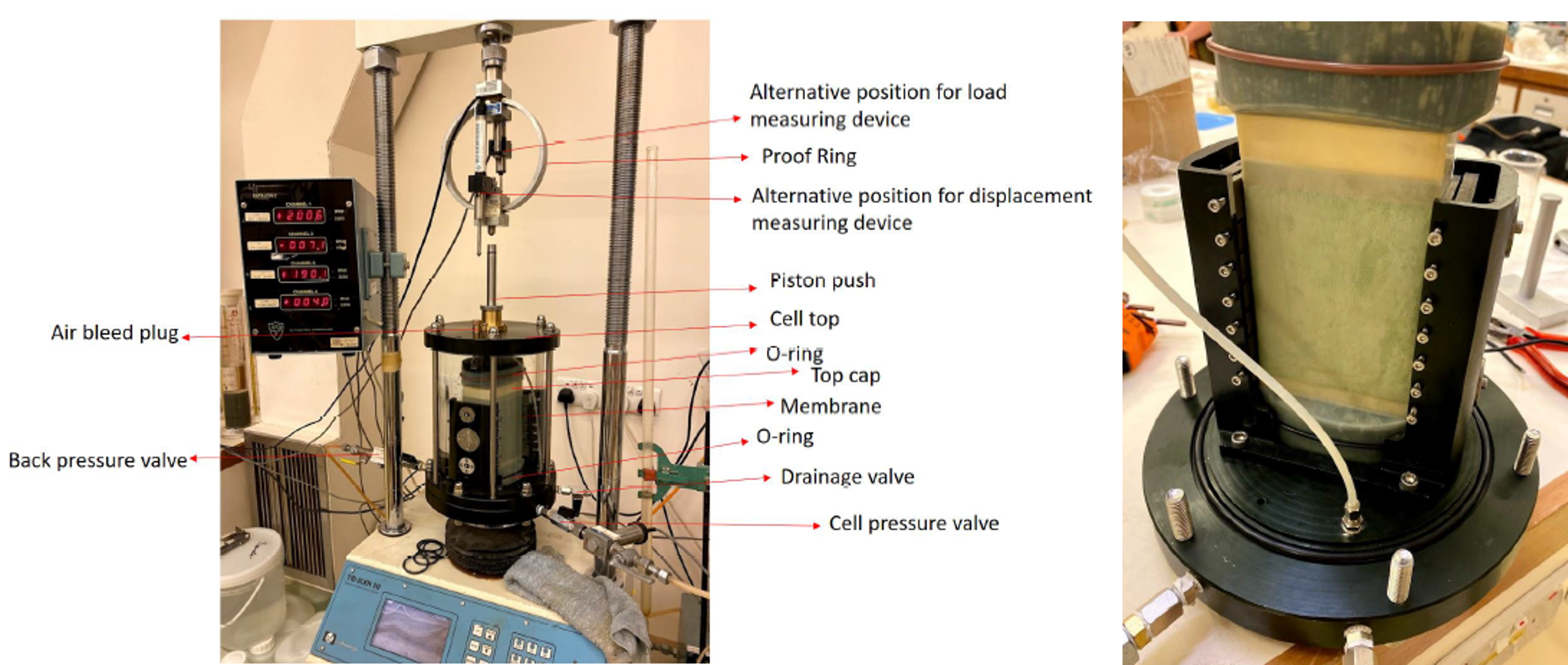
2.5 High-pressure temperature-controlled triaxial apparatus
The Multifunctional Soil Testing Apparatus is a highThe independently developed high-pressure temperature-controlled triaxial apparatus represents a significant advancement in geotechnical testing technology. Its groundbreaking capability lies in the precise control of effective stress with an accuracy of approximately 0.1 kPa, even under extreme confining and back pressures of up to 32 MPa. This innovative feature is particularly well-suited for evaluating the geo-mechanical properties of soils under ultra-deep-sea conditions, where high backpressure and low effective stress are prevalent. The achievement of this precision is made possible through a novel testing scheme that incorporates an additional differential pressure sensor between the confining pressure and backpressure sensors. Furthermore, the device is equipped with an advanced temperature control function, allowing for triaxial testing across a wide temperature range from -30°C to 100°C. This versatility, combined with its ability to operate under confining and backpressure ranging from 0 to 32 MPa, allows for a comprehensive suite of tests, including: (a) Monotonic triaxial tests for strength and critical state analysis; (b) Drained cyclic triaxial tests; (c) Undrained cyclic triaxial tests; (d) Cyclic loading tests at frequencies of up to 20 Hz; (e) Temperature-controlled triaxial tests.
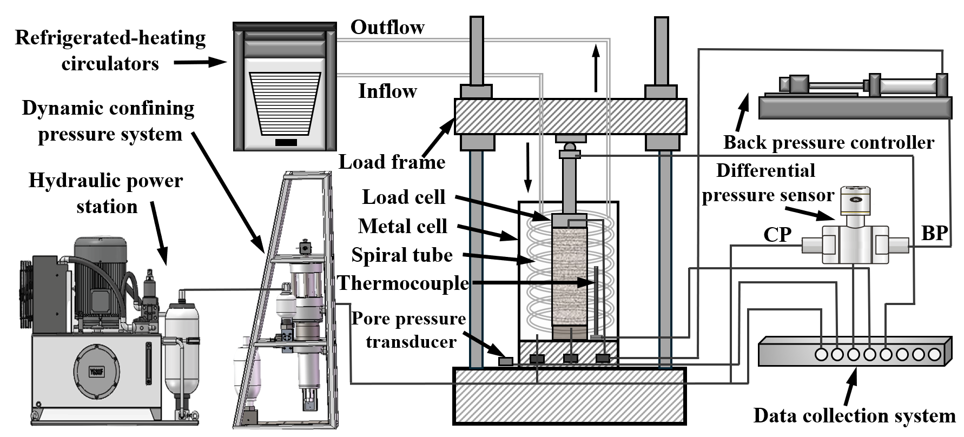
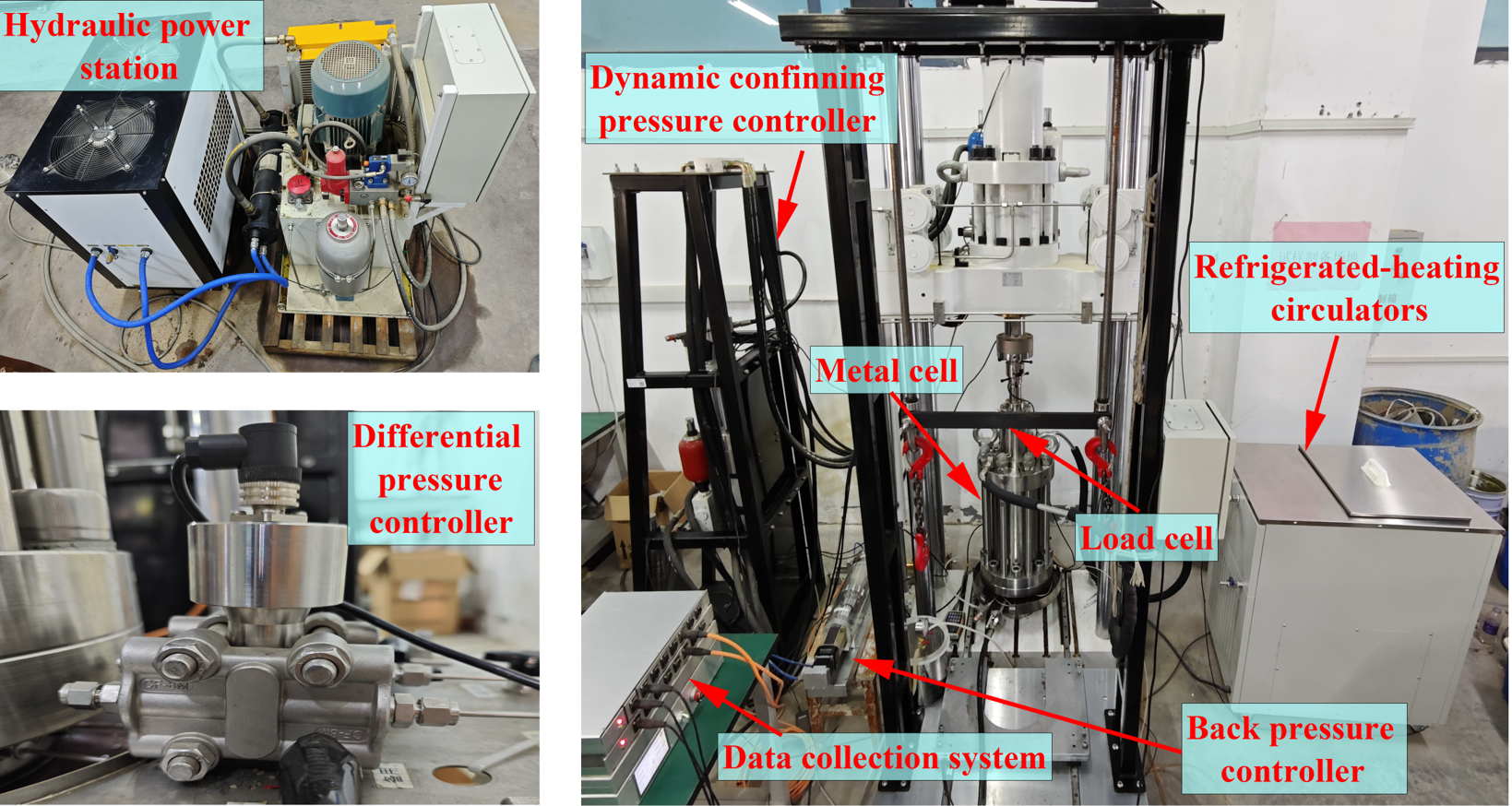
3.1 X-ray computed micro-tomography apparatus
Except for the macro-scale laboratory test and the large-scale model test, the microstructural identification for soils is also important to understand the underlying mechanisms for complex geotechnical problems. Recently, an X-ray computed microtomography apparatus XT H 225 ST (Nikon) has been installed in our department, with a minimum focal spot size of 1 μm, maximum energy of 225 kV, maximum power of 450 W for the X-ray source and minimum pixel size of 150 μm for the detector. The relevant microstructural investigation of soils can be completed using this facility with satisfactory resolution.

The Multifunctional Soil Testing Apparatus is a highly sophisticated, multifunctional soil mechanics testing system. This advanced apparatus is capable of performing a comprehensive array of geotechnical evaluations with high precision, owing to its flexible operations via a set of servo motors and its integration with specialized geotechnical software. The system can conduct standard triaxial tests, one-dimensional consolidation tests, and direct shear tests, making it an invaluable tool for soil analysis.
Compared to the traditional equipment, this system has the unique feature of working with the X-ray computed tomography (CT) technique. It is specifically designed so that it can be placed onto a CT scanner's load-bearing stage, which allows researchers to conduct CT-aided soil testing. This innovative feature enables the observation of internal deformation and failure patterns within the tested samples under external loading, all while preserving the sample's integrity.
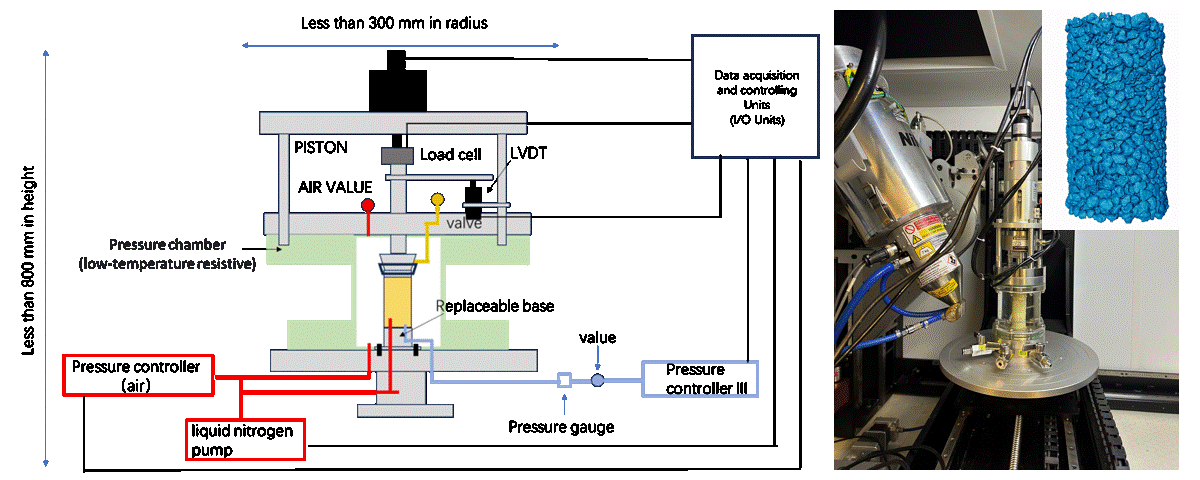
3.2 SEM and MIP testing
In the Department of the PI, we have the necessary testing apparatuses to clarify the soil microstructure by scanning electron microscope (SEM) and the soil pore size distribution by mercury intrusion porosimetry (MIP) test.
